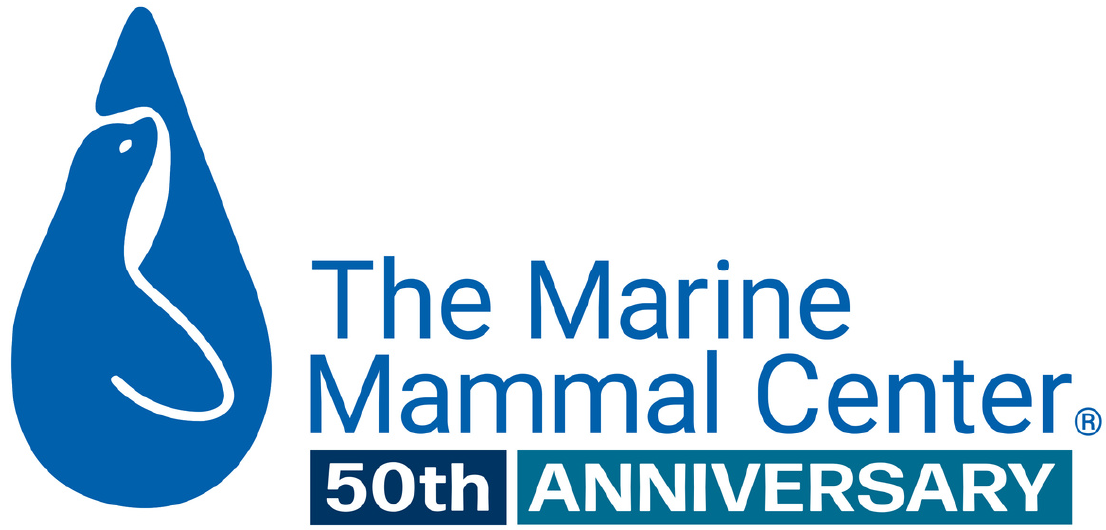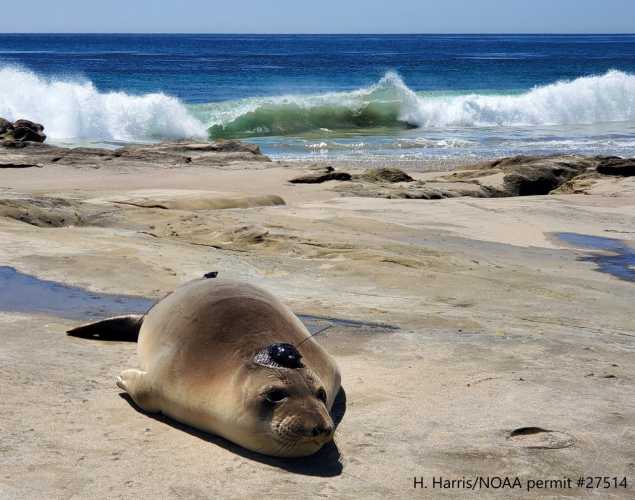
Studying Elephant Seals of the Central California Coast
- Natural history
- Medicine
- Population monitoring
Adult northern elephant seals are known to have one of the longest migrations of any mammal in the world, traveling up to 13,000 miles each year from shore to their feeding areas in the northern Pacific Ocean. The species spends the vast majority of their time—about nine months of the year—in the open ocean, only coming to shore twice each year to breed and molt.
Despite extensive research conducted on the migrations of adult seals, very little is known about elephant seal pups that have weaned from their mothers and venture into the ocean on their own for the first time. Experts at The Marine Mammal Center and California Polytechnic State University, San Luis Obispo (Cal Poly) have partnered on a multi-year research study to better understand the behaviors, migration paths and clinical health of these young animals.
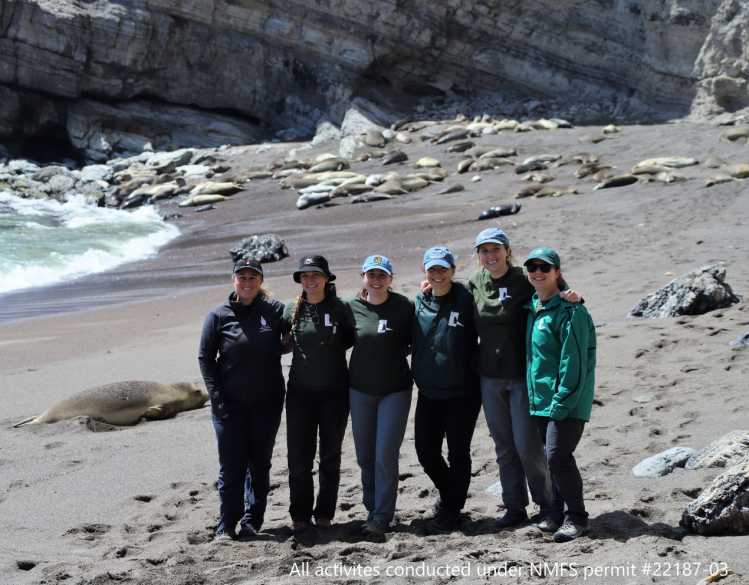
Studying Seals from Two California Breeding Beaches
Scientists at Vandenberg Space Force Base in Central California first observed newborn elephant seal pups on a small, remote beach on the base in 2017. The seals have returned every year since, claiming the area as a rookery, or breeding site.
Led by Cal Poly Associate Professor Dr. Heather Liwanag as the principal investigator and funded by Vandenberg Space Force Base (U.S. Army Corps of Engineers, Department of Defense), our collaborative study compares the movements and behaviors of pups born at this new rookery on Vandenberg Space Force Base to pups born at a longstanding rookery at Naval Base Ventura County on San Nicolas Island. Researchers monitor the elephant seal colonies at each site to better understand the population counts and dynamics, as well as study and track 10 weaned pups (five pups per rookery) each year throughout their first migration.


The research team travels by plane to study the elephant seals on San Nicolas Island, the farthest from shore of California’s Channel Islands. And the trek to the seals at Vandenberg Space Force Base is certainly an adventure as well—in fact, the remote beach is only accessible to researchers by rope, rappelling with the help of experienced climbers. Holding steady to the ropes with their heavy gear secured, our veterinary experts climb down the rocky cliffs alongside partners at Cal Poly and Vandenberg Space Force Base.


Tracking the Pups’ Movements in Real-Time
Once on the beach, researchers attach temporary satellite tags to the elephant seal pups’ heads using an animal-safe marine epoxy and mesh patch. Scientists can then track the pups’ geographical movements in real-time throughout their first migration to understand where and how far they travel to forage for food.
You can meet this year’s tagged pups and watch their movements on a live map here!

Last year’s tracking study revealed that a pup named Monarch traveled all the way up to Alaska and back to the rookery on Vandenberg Space Force Base, returning 73 pounds heavier. Swimming nearly 5,000 miles to forage for food, Monarch went well beyond what researchers previously believed a young elephant seal pup could travel on its first migration.

As this conservation technology enables researchers to monitor animals across the farthest stretches of the sea, satellite tags allow us to learn more about how marine mammals use their ocean environment and help inform critical efforts to protect them.
Providing Veterinary Expertise
The Center’s veterinarian Dr. Heather Harris and registered veterinary technicians Lauren Campbell and Liz Eby provide their animal care skills and knowledge to make this research possible, including sedating and monitoring the tagged elephant seals.
Sedating the elephant seals is crucial to conducting the research safely, as it allows the animals to be calm enough to not endanger themselves or the scientists during hands-on conservation work like attaching and removing satellite tags.

The amount of sedative varies from animal to animal, as it is based on their weight, age and body condition. In order to determine weight, the research team carefully lifts the animals up with a specially designed canvas weigh bag and a tripod with a hanging scale.

Then using a syringe, sometimes on an extended pole, the Center’s veterinary team safely administers the precise amount of sedative. During the entire time the pups are sedated, our experts closely monitor their vital signs like heartbeat and breathing rates.

Training and Working Alongside the Next Generation of Marine Mammal Scientists
The research to understand weaned pup migrations is led by Katie Saenger, a wildlife biologist and graduate student at Cal Poly. While Katie works closely with our veterinary team in a research capacity today, she first became involved with the Center as an undergraduate student in 2020.
The Center’s veterinary experts are studying critical health issues that impact our ocean and marine mammals—and through our Teaching Hospital, we train the next generation to address these issues on a global scale. As part of our Teaching Hospital, each year we partner with Cal Poly to offer a marine mammal health course developed and led by Dr. Harris, who serves as both Associate Veterinarian for the Center and faculty at Cal Poly. This unique course includes an integrated, hands-on learning experience working with seals, sea lions and sea otters at the Center.

As an undergraduate student in our collaborative health course, Katie had the opportunity to join the Center’s volunteer crews rehabilitating sick and injured marine mammals. In addition to learning about clinical health in lectures and workshops, she trained with our experts to care for many young elephant seals during pupping season, including feeding patients, attaching IV fluids and more.
Alumni of the Center’s Teaching Hospital frequently become leading contributors in their field, and our collaborative health course helped provide Katie with a solid foundation in marine mammal science. She’s excited to continue working alongside our veterinary experts—now as a graduate student researcher in Dr. Liwanag’s Vertebrate Integrative Physiology Lab at Cal Poly—leading the team for her thesis project and filling crucial knowledge gaps in the life history of northern elephant seals.


Conducting Disease Investigation Research
In addition to working with our partners at Cal Poly to understand weaned pups’ movements and behaviors, Dr. Harris expanded the study to include the pups’ clinical health as part of the Center’s ongoing disease investigation research.

As the world’s largest marine mammal hospital, the Center gathers an extraordinary amount of information from our sick and injured patients, and we have created a robust collection of data and health samples in our clinical laboratory. Our researchers process and analyze thousands of samples collected from rescued marine mammals such as blood, tissue, blubber and fur.
In order to identify a stranded animal’s ailments and continue developing innovative medical techniques, it’s critical to first understand what a healthy animal is supposed to look like. So, while the weaned pups at San Nicolas Island and Vandenberg Space Force Base are already sedated for satellite tag recovery, our veterinary experts have the unique scientific opportunity to collect samples from these healthy wild elephant seals.
Blood, fur and other samples collected from the healthy seals in the wild are analyzed and used as study comparisons to sick patients rehabilitating at our hospital. Common diseases we are studying that we see in our elephant seal patients include lymphoma, herpesvirus, skin diseases and parasites like lungworm.

Results from clinical health samples support our experts in identifying diseases and pathogens in our patients, investigating the reasons why marine mammals strand and determining how these factors are connected to ecosystem and human health.
Advancing Ocean Health
Thanks to support from people like you, the Center’s experts have the resources needed to conduct key research and contribute to global knowledge about marine mammal health and conservation. From gaining insights into the life histories of elephant seals to studying emerging diseases that affect them, this work is integral to protecting marine mammals and the ocean ecosystems that are vital to the health of all life on Earth. And by training the next generation of marine mammal scientists and working closely with our partners, we are expanding our impact around the world to advance ocean health.
Life-Saving Disentanglement Frees Northern Elephant Seal Liddie from Ocean Trash

While studying weaned pups at Vandenberg Space Force base, the research team spotted a skinny elephant seal by the seaside cliffs entangled in ocean trash. Among the researchers were the Center’s veterinary experts, already stocked with the medical supplies and equipment necessary to launch a life-saving rescue mission on the beach.
Yes, I want to save a life!
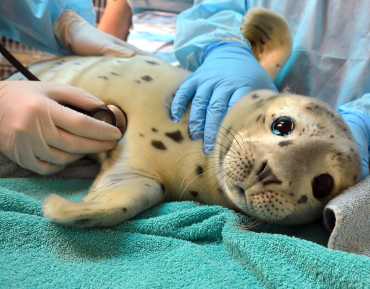
Yes, I want to save a life!
You’ll be giving sick and injured animals the best possible care at the Center’s state-of-the-art hospital. With your gift today, you are giving a patient a second chance at life in the wild.
See Our Latest News
{"image":"\/Animals\/Patients\/Harbor seals\/2020\/cropped-images\/hs-barnwood-by-bill-hunnewell-c-the-marine-mammal-center-315-0-3299-2577-1607370547.jpg","alt":"harbor seal Barnwood","title":"Last-Minute Gift Guide \u2013 Top Gifts that Give Back to Marine Animals","link_url":"https:\/\/www.marinemammalcenter.org\/news\/last-minute-gift-guide","label":"News Update","date":"2025-12-18 01:00:00"}
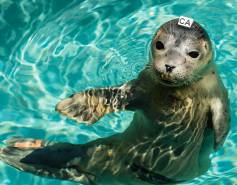
Last-Minute Gift Guide – Top Gifts that Give Back to Marine Animals
December 18, 2025
Read More{"image":"\/Animals\/Patients\/Hawaiian monk seals\/2025\/cropped-images\/b-ru72admission-to-ke-kai-ola112125photo-c-the-marine-mammal-center-noaa-permit-24359-0-364-1270-992-1766095407.jpg","alt":"A newborn Hawaiian monk seal pup with a black coat in rehabilitative care.","title":"Newborn Hawaiian Monk Seal Pup Now Receiving Care","link_url":"https:\/\/www.marinemammalcenter.org\/news\/newborn-hawaiian-monk-seal-pup-now-receiving-care","label":"Patient Update","date":"2025-12-18 01:00:00"}

{"image":"\/Animals\/Patients\/Hawaiian monk seals\/2025\/cropped-images\/d-ru28release-exam-at-ke-kai-ola111025photo-by-giancarlo-rulli-c-the-marine-mammal-center-noaa-permit-24359-0-0-1270-992-1764620886.jpg","alt":"","title":"Bird Flu Vaccine Trial Offers Hope for Protecting Hawaiian Monk Seals","link_url":"https:\/\/www.marinemammalcenter.org\/news\/bird-flu-vaccine-trial-may-offer-hope-for-protecting-hawaiian-monk-seals","label":"News Update","date":"2025-12-01 08:13:00"}

Bird Flu Vaccine Trial Offers Hope for Protecting Hawaiian Monk Seals
December 1, 2025
Read More{"image":"\/Animals\/Patients\/Hawaiian monk seals\/2021\/hms-pp08-by-sheila-latta-c-the-marine-mammal-center-noaa-permit-18786.jpg","alt":"Hawaiian monk seal","title":"The New York Times: Inside the Bird-Flu Vaccine Trial for Monk Seals","link_url":"https:\/\/www.marinemammalcenter.org\/news\/the-new-york-times-inside-the-bird-flu-vaccine-trial-for-monk-seals","label":"In the News","date":"2025-12-01 01:00:00"}

The New York Times: Inside the Bird-Flu Vaccine Trial for Monk Seals
December 1, 2025
Read More